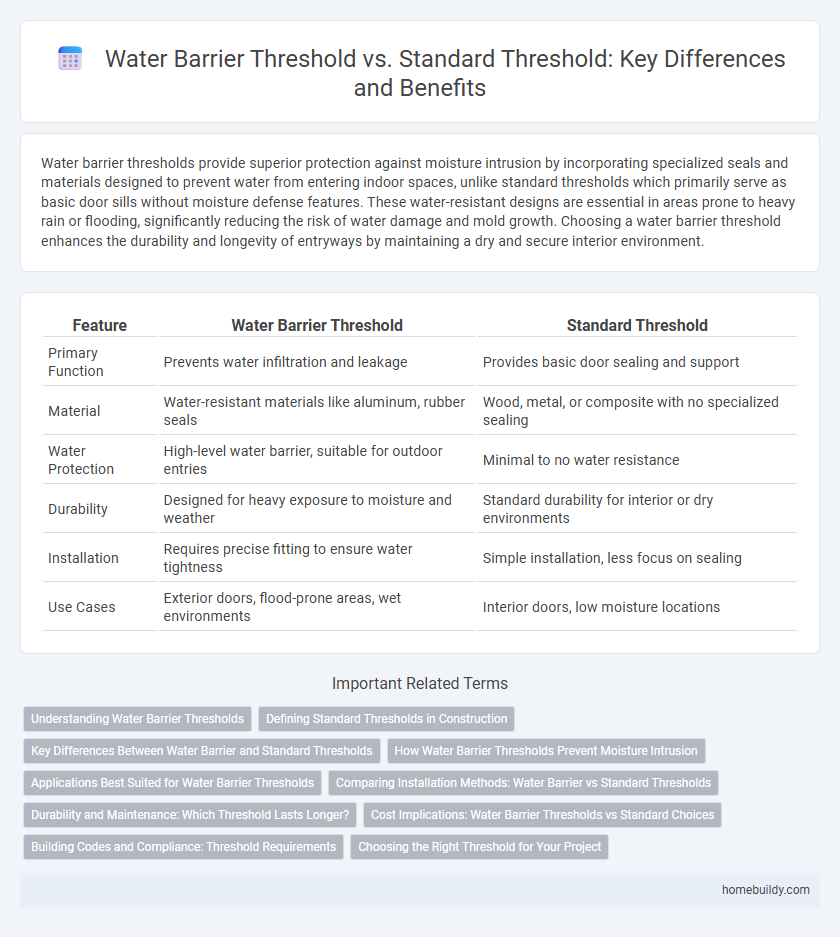Water barrier thresholds provide superior protection against moisture intrusion by incorporating specialized seals and materials designed to prevent water from entering indoor spaces, unlike standard thresholds which primarily serve as basic door sills without moisture defense features. These water-resistant designs are essential in areas prone to heavy rain or flooding, significantly reducing the risk of water damage and mold growth. Choosing a water barrier threshold enhances the durability and longevity of entryways by maintaining a dry and secure interior environment.
Table of Comparison
| Feature | Water Barrier Threshold | Standard Threshold |
|---|---|---|
| Primary Function | Prevents water infiltration and leakage | Provides basic door sealing and support |
| Material | Water-resistant materials like aluminum, rubber seals | Wood, metal, or composite with no specialized sealing |
| Water Protection | High-level water barrier, suitable for outdoor entries | Minimal to no water resistance |
| Durability | Designed for heavy exposure to moisture and weather | Standard durability for interior or dry environments |
| Installation | Requires precise fitting to ensure water tightness | Simple installation, less focus on sealing |
| Use Cases | Exterior doors, flood-prone areas, wet environments | Interior doors, low moisture locations |
Understanding Water Barrier Thresholds
Water barrier thresholds are specifically designed to prevent water intrusion by incorporating raised edges and durable sealing materials, unlike standard thresholds that primarily focus on providing a smooth transition between rooms. These thresholds utilize waterproof membranes and robust construction to block water from seeping under doors during heavy rain or flooding. Understanding water barrier thresholds helps homeowners and builders select effective solutions for moisture control and interior protection.
Defining Standard Thresholds in Construction
Standard thresholds in construction establish the baseline dimensions, materials, and structural requirements for door sills to ensure durability, safety, and compliance with building codes. These thresholds typically feature low profiles with weather-resistant properties but do not include integrated water barriers. Unlike water barrier thresholds designed specifically to prevent water infiltration, standard thresholds prioritize ease of installation and general functionality within architectural standards.
Key Differences Between Water Barrier and Standard Thresholds
Water barrier thresholds feature integrated seals and raised edges designed to prevent water infiltration, making them ideal for exterior doors exposed to rain and moisture. Standard thresholds typically lack these waterproofing elements and focus primarily on providing a smooth transition between flooring surfaces indoors. The key differences lie in the water-resistant construction and sealing capabilities of water barrier thresholds versus the basic structural function of standard thresholds.
How Water Barrier Thresholds Prevent Moisture Intrusion
Water barrier thresholds feature integrated seals and raised edges that create a watertight barrier, effectively preventing moisture from seeping underneath doors. The materials used, such as rubber or vinyl gaskets, enhance their resistance to water penetration compared to standard thresholds made of wood or aluminum with no sealing properties. This design significantly reduces the risk of mold, mildew, and structural damage caused by prolonged moisture exposure.
Applications Best Suited for Water Barrier Thresholds
Water barrier thresholds are specifically designed for applications requiring enhanced protection against water intrusion, making them ideal for exterior doors in flood-prone or heavy rainfall areas. They feature integrated seals and raised edges to prevent water seepage, outperforming standard thresholds that primarily address air and debris infiltration. Commercial buildings, coastal homes, and flood zones benefit most from water barrier thresholds due to their superior durability and water resistance.
Comparing Installation Methods: Water Barrier vs Standard Thresholds
Water barrier thresholds require precise sealing techniques and integration with waterproof membranes to prevent water infiltration effectively, while standard thresholds typically involve simpler installation focused on structural support without specialized water resistance. The installation of water barrier thresholds often demands additional steps such as the application of sealants and flashing to ensure a continuous waterproof barrier. Standard thresholds may rely primarily on mechanical fasteners and basic caulking, resulting in less protection against moisture penetration compared to water barrier variants.
Durability and Maintenance: Which Threshold Lasts Longer?
Water barrier thresholds feature advanced materials and sealed designs that effectively prevent water infiltration, resulting in enhanced durability compared to standard thresholds. Standard thresholds, often constructed from basic metals or wood with minimal sealing, are prone to wear and water damage, leading to higher maintenance needs over time. The superior water resistance of water barrier thresholds significantly extends their lifespan while reducing repair and upkeep frequency.
Cost Implications: Water Barrier Thresholds vs Standard Choices
Water barrier thresholds typically involve higher upfront costs due to specialized materials and installation techniques that prevent water intrusion, whereas standard thresholds require lower initial investment but may incur greater long-term expenses from water damage repairs and maintenance. Investing in water barrier thresholds reduces risks of structural damage and mold growth, potentially lowering insurance premiums and increasing property value. Standard thresholds might be more common in budget projects but often lead to additional costs related to water remediation and associated health hazards.
Building Codes and Compliance: Threshold Requirements
Water barrier thresholds provide superior protection against moisture intrusion compared to standard thresholds, meeting stricter building code requirements for wet areas and exterior doors. Building codes such as the International Residential Code (IRC) mandate threshold designs that prevent water infiltration to ensure durability and indoor air quality. Compliance with these regulations often necessitates using water-resistant materials and integrated sealing mechanisms found in water barrier thresholds.
Choosing the Right Threshold for Your Project
Water barrier thresholds provide superior protection against water intrusion by incorporating a raised lip or seal, making them ideal for exterior doors prone to heavy rain or flooding. Standard thresholds, typically flat and less resistant to moisture, suit interior doors or low-exposure areas where water resistance is not critical. Choosing the right threshold depends on evaluating environmental conditions, door location, and the level of water protection needed for long-term durability and energy efficiency.
Water Barrier Threshold vs Standard Threshold Infographic

 homebuildy.com
homebuildy.com